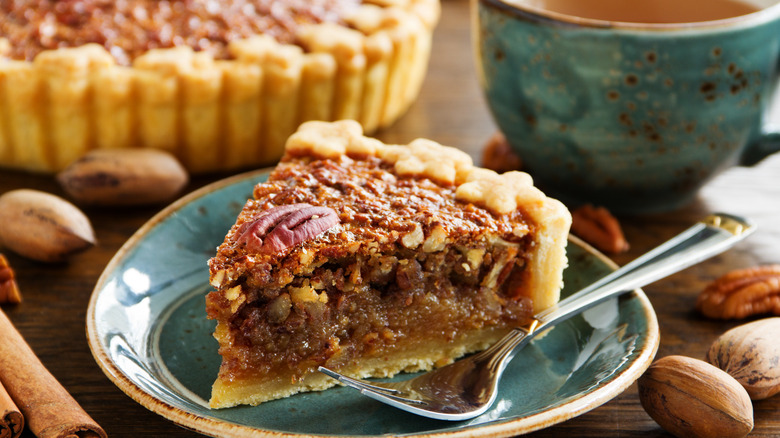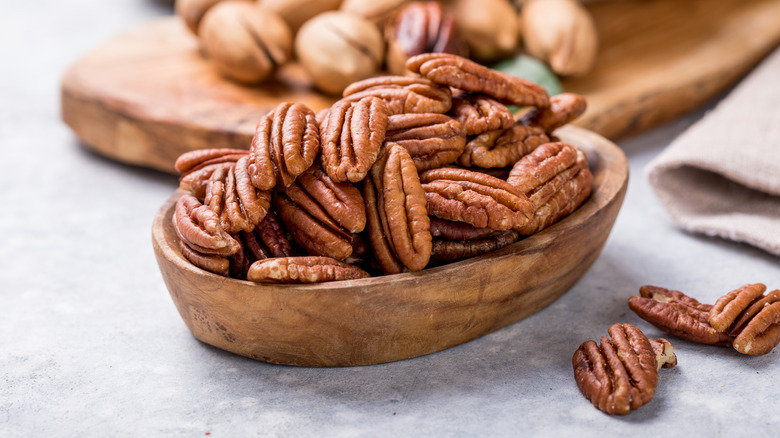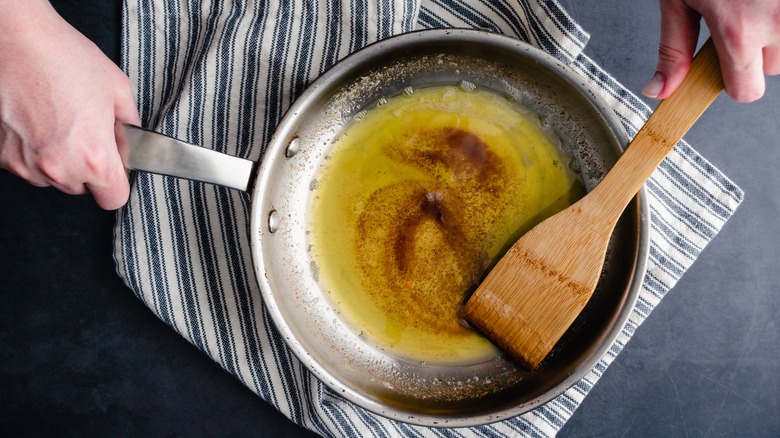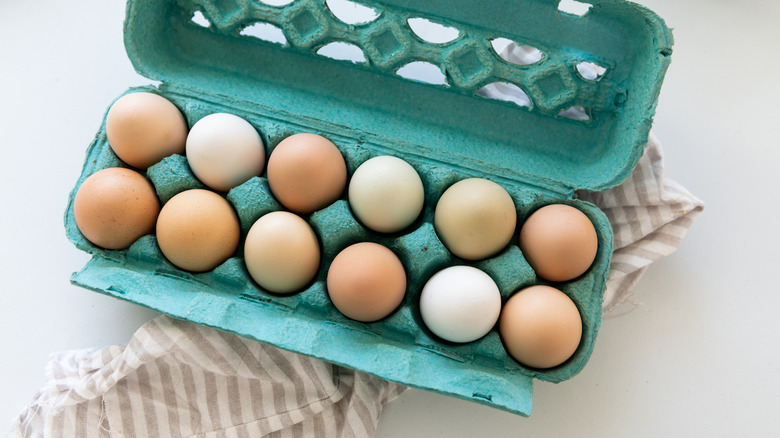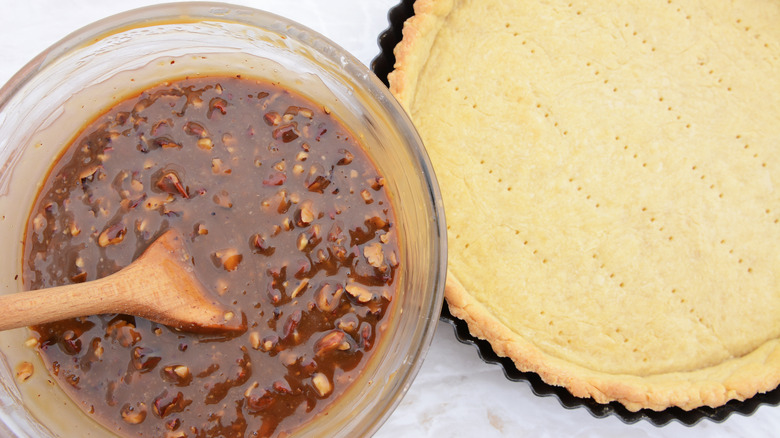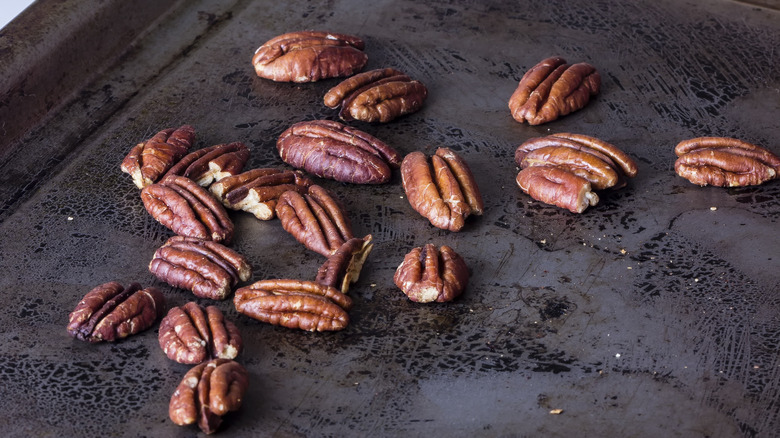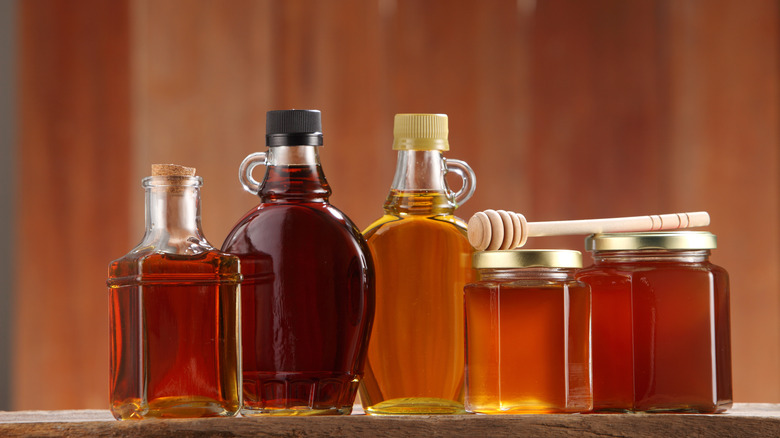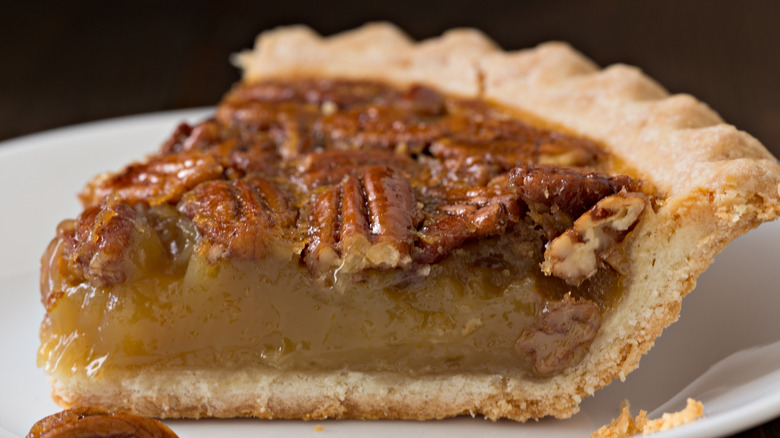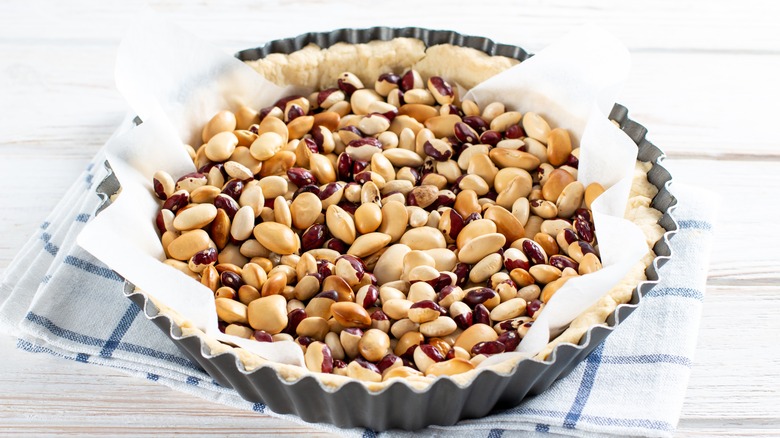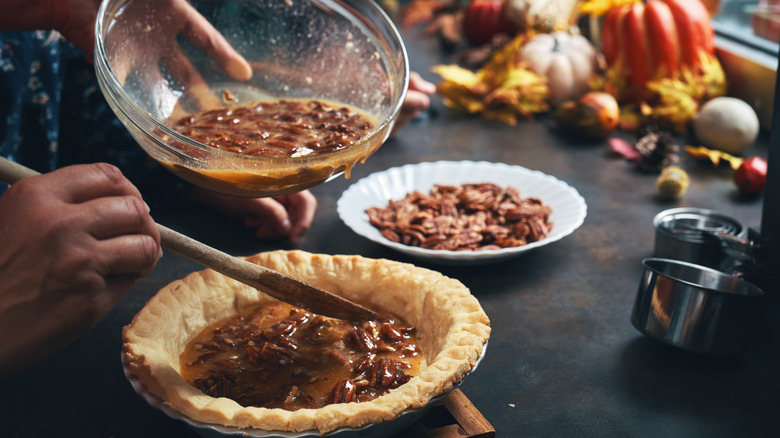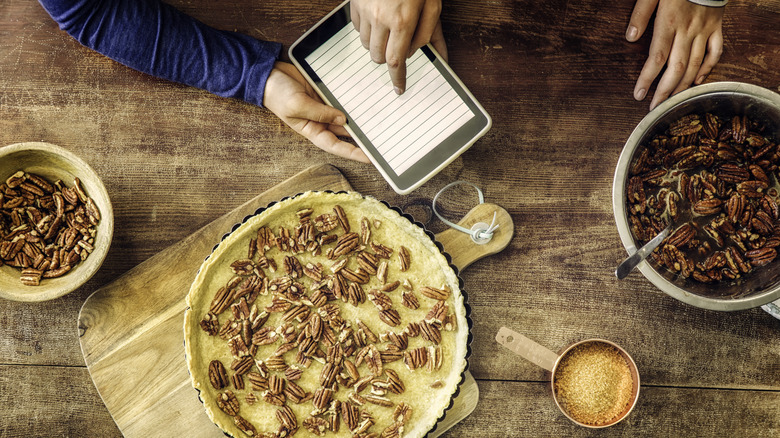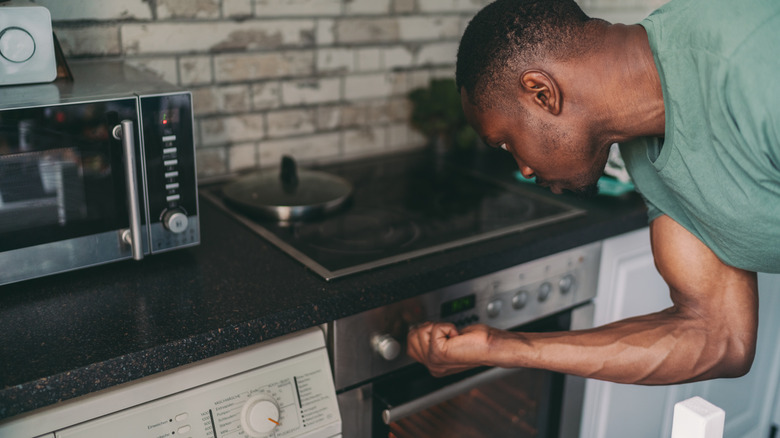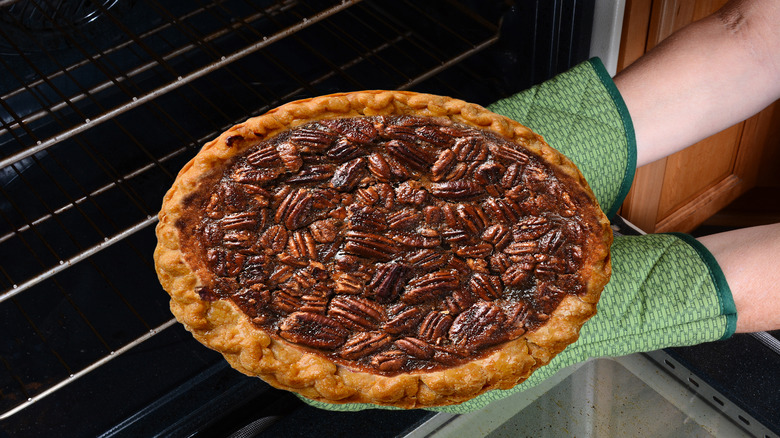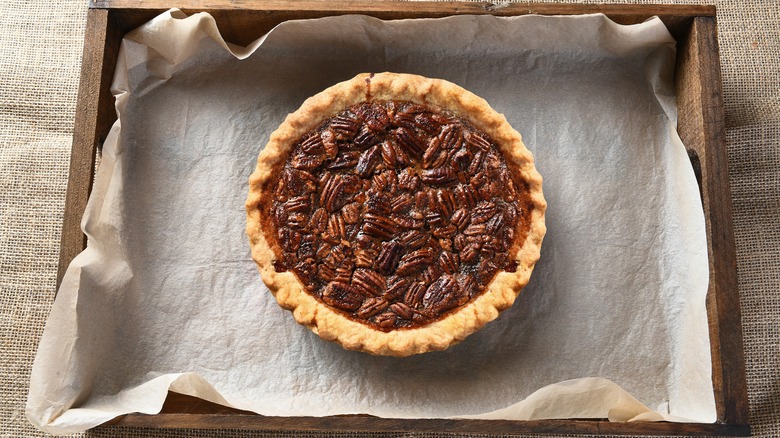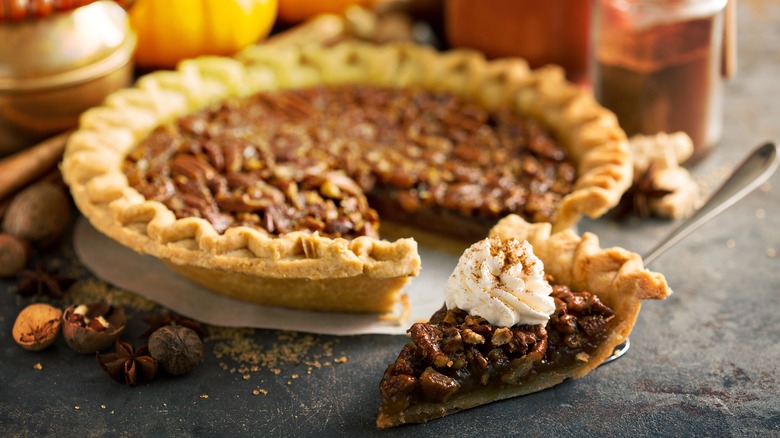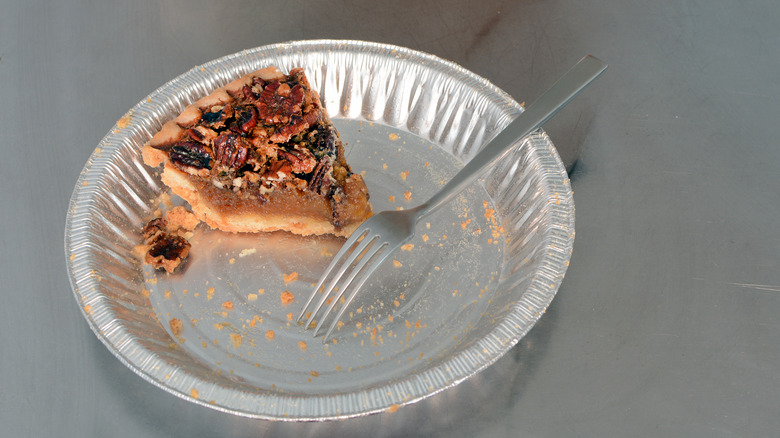16 Tips For Making A Perfect Pecan Pie
Perhaps what makes a pecan pie so fabulous isn't just the crispy nuts, silky filling, or buttery crust but the heavenly balance of all three. Aside from its comforting textures and flavors, what adds to its charm is that the filling only requires a few ingredients (eggs, butter, vanilla, and sweeteners). Although the dessert's origin is uncertain, it's possible that Native Americans may have introduced pecans to French settlers who later crafted the pie. However, pecan pie became a Southern staple since pecans are native to the South, and some of the first known recipes came from Texas in the 1800s.
The dessert also became a Thanksgiving tradition because autumn is the harvesting season for pecans. Nevertheless, you don't need to be from the South or wait for a holiday to make it. Despite the basic formula and simple baking methods, you still need certain pointers to make an outstanding pecan pie. Multiple factors control the outcome, from the type of pecan you use to the oven temperature, so it's essential to know these tips before you break out the rolling pins and pie dishes.
1. Choose your pecans wisely
To make the best pie possible, you must consider the little details people often overlook, such as which pecan variety to use. Although it's easy to pick up a bag of pecans and not think about their variety, you might not purchase the best type this way. Any pecan will indeed do, but some varieties, such as Elliott and Pawnee, upgrade the pie significantly in terms of taste and texture.
Elliott pecans are a specialty type with a rich and indulgent flavor. They have a uniform appearance, and their buttery texture is suitable for baking, so they hit every mark. Meanwhile, the Pawnee variety also has impressive quality with a deep, nutty taste. Depending on where you live, you might have to special-order these kinds of pecans online. If you plan to use nuts you already have stocked in your pantry, check the best-by date. Give them a quick taste and smell test to ensure there aren't any rancid undertones or a stale mouthfeel that can negatively affect the final product.
2. Brown the butter
A simple way to give the dessert a more complex flavor is to cook the butter beforehand to make a brown butter pecan pie. Since most recipes require melted butter anyway, it doesn't alter the consistency of the filling, which is a plus. When you make brown butter, you create the Maillard reaction (the chemical reaction when certain foods turn darker in color, which causes them to have a deeper flavor).
The key to making the perfect brown butter is not to overdo it since it's pretty easy to burn once it reaches a particular stage. Not to mention, it continues to cook even after you remove it from the stove. Heat the butter in a light-colored pan over medium heat to allow the fat to melt and the water content to evaporate. After a few minutes, the butter turns darker and has a pleasant toasty smell. Aside from the aroma, you know it's done when you can see tiny brown specks. Transfer it to a heat-proof container and allow it to cool some before you use it in your pie.
3. Use room-temperature eggs
You might not think this is too big of a deal, but the temperature of your eggs actually determines how successfully your custard base forms. To keep it safe, remove the eggs from the cooler at least 30 minutes (or up to 1 hour) before you use them in the recipe. When you use eggs straight from the refrigerator, it's harder for them to disperse throughout the mixture thoroughly and evenly.
If you've ever tried to scramble cold eggs, this might be familiar to you as sometimes the whites and yolks are stubborn, and it takes a lot of elbow grease to combine them. Furthermore, if you're not careful, the differing temperatures between the butter and the eggs can cause major issues. The warm fat creates tiny cooked egg pieces, the cold eggs make the butter solidify, or a combination of both, resulting in a chunky consistency.
4. Add some bourbon
If you're open to giving your pie a boozy lift, bourbon is the right choice because it pairs wonderfully with the ingredients. Specifically, bourbon complements foods with nutty, sugary, and vanilla-like tones, which is the exact essence of this dessert. Take advantage of bourbon's warm flavor by adding a small amount to the custard base. You only need 1 or 2 tablespoons to get the job done. Another option is to include it in the pie crust. When you add alcohol to pastries like pie dough, it provides moisture and improves the overall consistency.
Ideally, replace a portion of the liquid in the recipe with the bourbon to avoid making the dough too sticky. If you can't decide which way to use it, take some inspiration from The Pioneer Woman; Ree Drummond adds bourbon to her pecan pie in every step, adding it to both the filling and the dough. Don't worry about the alcohol flavor being too potent. As long as you stick to a small amount, its flavor mellows out once you bake it, and it fuses with the other elements to create a delicious, sophisticated flavor.
5. Mix the filling by hand
For the optimal texture, mix the filling by hand. Make sure to use a large enough bowl to comfortably whisk the ingredients, ensuring you reach the bottom of the bowl and do not miss any sugar that might stick. Pecan pie filling is not supposed to be super light and airy after it bakes; rather, it should be on the gooey, softer side.
Unfortunately, when you mix too much air into the batter, it negatively affects the consistency. First, the pie expands more than it should during baking, which causes it to spill over and create a mess in the oven. Moreover, there's a higher chance the pie ends up collapsing after you remove it from the oven, which ruins the presentation. While your handy-dandy stand mixer does make things a lot easier for other baking projects, you can let it sit out for this one. Mixing it the old-fashioned way is perfectly effective.
6. Toast the nuts
Before you ask, no, the nuts in the pie don't burn if you toast them beforehand. And yes, toasting them does make a difference. Although it seems like they would toast during baking, only the pecans on the face of the pie do (you can reserve some untoasted nuts for the top layer). The other nuts beneath the surface are surrounded by custard, which makes it hard for them to take on that lovely, toasty flavor. Even though this is an optional step, it's worth it for flavor and presentation purposes.
The best way to enhance the natural flavor of the pecans is to cook them low and slow, so don't rush the process. These nuts are rather delicate and burn easily, especially if you choose a variety like Elliott, which is naturally oily. So, don't put them in an oven over 325 degrees Fahrenheit. Spread them out on a sheet pan in a single layer with some space in between so the heat reaches every side of them. Flip them over after roughly 5 to 7 minutes to toast the other side, and the nuts are ready to make your pie even more decadent.
7. Experiment with sweeteners
The typical go-to sweetener for sweet and sticky pecan pie is corn syrup, which produces a beautiful texture, but some folks find it overly saccharine. Or perhaps you enjoy corn syrup but just want to try something different. Luckily, there are numerous products you can use as substitutes. For instance, use natural sweeteners like pure maple syrup, honey, or agave. These products are similar to corn syrup since they're liquid. Even if they are a bit thinner, you can use them with a one-to-one ratio.
Maple syrup has warm, caramel-like notes that perfectly match the nuts and vanilla. Meanwhile, agave has more of a neutral flavor, like corn syrup. Then, you have honey, which makes itself known in any recipe. With this option, you'll likely end up with a honey pecan pie, and there's nothing to complain about there. Lastly, if you're not fond of super sweet desserts, try something like Lyle's Golden Syrup, made from natural sugar cane, which is buttery and milder. It simply brings out the best qualities of the nuts.
8. Choose a crust that's flaky
The best pecan pies have flaky crusts contrasting crispy nuts and sweet, chewy filling. Ideally, you want it to create a nice balance to the dessert: not too sugary and not tough in consistency. There are many types of dough you can use as the base. Although it's possible to make shortcrust that's flaky, it is usually more comparable to cookie dough because it's denser and sweeter. Meanwhile, puff pastry is light and buttery but might not hold the weight of the heavy filling. Thus, traditional flaky pastry is the most ideal.
The vital step to making this type of pastry is to use cold butter, specifically tiny pieces that you incorporate throughout the flour and other ingredients. Then, when you bake the dough, the pockets of butter create steam, which results in light, tender layers in the crust. Once you choose your recipe, follow the instructions regarding the butter and temperature. If you want to go the extra mile, you can use the cheese grater hack to make your pie crust flakier. Use a grater to form butter shreds rather than chopping cubes by hand, leading to a more even distribution throughout the dough.
9. Blind bake the crust
Making a good pecan pie is possible without blind baking the crust. But the question is, is it always worth the risk? The base of pecan pie is technically a custard. Traditionally, it is a standard for bakers to blind-bake custard pies since the filling is wet and can interfere with the crust's texture. If you par-bake the dough, it provides a solid foundation for the custard to sit on. Additionally, there's less chance of the bottom being soggy.
So, all you need to do is line the empty shell with parchment, fill it with pie weights, and bake it until it is firm to the touch and barely turning golden. Most people weary of par-baking are nervous about the crust burning. However, there are special tricks that maintain the quality of the crust. For example, you can use the aluminum foil hack that saves the edges of your pie crust by shielding it. If your pie, filling and all, is in the oven, and you notice the border has enough color, you can simply wrap the rim of the pie with foil and finish baking it.
10. Don't overfill the pie shell
If you ever have trouble with a pecan pie sticking to the pan, it might be due to an overfilled crust. Make sure to leave a small gap between the top of the custard and the brim of the pie. Then, if you notice any air bubbles after you pour the custard, gently lift and tap the raw pie on the table to pop any unwanted pockets. It's tempting to fill it to the top if you want the result to look nice and full. However, when you add too much, it's easy for the sugary mixture to seep in between the crust and the pan.
Even if it doesn't spill over when you bake it, it can still find its way into crevices with any movement, like when you transfer it from the counter to the oven. The problem is that the sugary custard in the gap hardens when you bake it, turning to a texture similar to hard candy. To divvy up your pie into beautiful slices, you can't have any of that mixture sticking to the pan (it's even more difficult with disposable pie tins). Lastly, if you overfill it, the custard might cook onto the crust, which makes it look sloppy.
11. Consider adjusting the amount of pecans
Depending on where you're from and what your preferences are, you might enjoy pecan pie with more or less nuts than your recipe calls for. There's a debate on whether the dessert should have pecans throughout the entire filling or just sit on top, with the gooey mixture underneath. Either version still counts as a pecan pie, and you have the freedom to make it however you want.
If you love a pecan-packed pie, increasing the number of nuts is a good idea. Instead of mixing the pecans into the sugary mixture, try a different route. Gradually add the custard to the pecans until you evenly coat them, with some extra custard at the bottom of the bowl. Then, you can pack it into the pie shell and add more base or nuts if needed. On the other hand, any nuts you put in the pie crust first will rise during baking, so it gives a good visible indication of how condensed the pecans will actually be.
12. Use the correct oven temperature
When you make your scrumptious pie, bake it at a moderate temperature. There are legitimate reasons for doing this. First, the eggs get too hot and curdle if exposed to too high temperatures. This results in a lumpy, broken filling that looks unappetizing and doesn't set properly. Additionally, there's a chance that the top of the pie cooks so much that the nuts burn before the center is ready.
To avoid any issues, aim to set your oven somewhere between 325 and 350 degrees Fahrenheit to guarantee that the oven gently heats the components. If you par-bake the crust at a higher temperature, like 425 degrees Fahrenheit, allow the oven to cool down before you return the pie with the filling. The best option is to use an oven thermometer to verify that the displayed number on the appliance is correct and you have the green light to bake the dessert.
13. Check the temperature of the pie before removing it from the oven
Although estimated baking times on recipes are helpful guides, you must check the pie's temperature and consistency to determine if it's done. Pecan pie has an egg-rich base, so it must reach 200 degrees Fahrenheit to gel. When it's approaching the end of the bake time, insert a cooking thermometer into the center of the pie to check it. In terms of consistency, you can also perform a "jiggle test" if you gently shake the pie to observe how the filling moves.
A perfectly baked pecan pie has slight movement in the center with the edges set. You don't want to see full-on ripples throughout the whole thing when you move it. These steps are crucial with this type of pie because simply guessing if you can take it out produces unsatisfactory results. Namely, under-baked pies are loose and unsafe to eat, while over-baked pies are rock-hard and lack that velvety, almost pudding-like center.
14. Allow it to rest after baking
Once you bake your magnificent dessert, allow time for it to rest. It's hard to resist slicing right into it, but unfortunately, if it's still super warm, the filling is runny. As a matter of fact, the custard carryover cooks even after you move it to a cooling rack or tray. Therefore, it needs time to set and reach its full potential — think one to two hours at least, but it's dependent on your kitchen's temperature.
You know it's ready to serve when you touch it with your hand, and it no longer feels warm. Transfer it to the refrigerator if it's still not cool enough at the two hour mark. It can be stressful when you need to make dessert for an event and are unsure if it will be ready in time. In cases like this, it's worth it to assemble and bake the pie the day before, so there's no questioning whether it will be ready.
15. Go easy on the garnishes
Pecan pie is already decadent enough, so don't overdo it with toppings. In reality, you don't need any garnishes, but if you want to upgrade the presentation for special occasions, that's understandable. People generally don't typically put whipped cream borders on these pies. But, if you wish to serve it with whipped cream, stick to a small dollop on each slice instead. Another option is to use garnishes that you can easily remove.
For example, orange's sweet-tart flavor pairs well with the warm, nutty dessert. Slice a few orange wedges and arrange them nicely on the pie for a classy look (you can sprinkle zest on top, too). Furthermore, rosemary gives a sophisticated touch if you place whole sprigs on top of the finished pie, especially for holidays like Thanksgiving and Christmas. Alternatively, use fresh edible flowers if you want a more vibrant look that stands out.
16. Follow proper storage and shelf life guidelines
There's a slight misconception that sweets are okay to sit out since sugar can function as a preservative in certain circumstances. However, sugar-filled or not, this pie isn't exempt from needing refrigeration because it has a custard base. The United States Department of Agriculture reports that all custard pies must be stored in cool conditions. To preserve its quality and freshness, cover it with a tight-fitting lid, plastic wrap, or aluminum foil.
In terms of its shelf life, consume the pie within three to four days after you make it. Fortunately, if you know you can't eat it all in that time frame, you can easily freeze it. If you enclose the pie with a few layers of plastic wrap to prevent any freezer burn, it lasts for upwards of three months. For optimal results, allow it to thaw in the refrigerator rather than microwave it.
